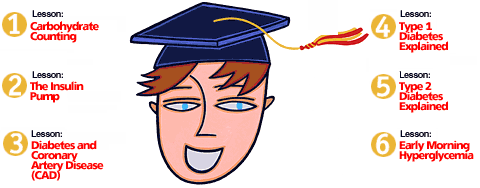



 |
|
|

|
|
Diabetes Lesson 1 - Carbohydrate Counting 
To get the most out of your carbohydrate counting efforts, do these three things:
This may take a little organization and patience to get the hang of it, but it will be worth your while. Your accurate records will help you understand how your lifestyle and habits affect your diabetes and will make it easier for you to adjust to the carbohydrate counting system. Just how much carbohydrate does my bagel have? Before the carbohydrate counting can begin, you need to figure out how much carbohydrate is in one serving of the foods you typically eat. If you are taking insulin, you'll be matching your insulin to the amount of carbohydrate you are eating, so it's important that you learn to do this meticulously right from the start. So, how do you do this? A fantastic resource is the Nutrition Facts label on the foods you buy. The label will list the grams of "Total Carbohydrates" in one serving of the food. Be sure to measure out the serving size listed on the food label to ensure that you are accurately counting the carbohydrate content of the portion you are actually eating. There are also computer programs that can analyze the various nutritional components of foods and meals, as well as pamphlets or at fast food places to learn about what you are about to eat. One word of caution though. Packaged and restaurant foods typically contain 2-3 times the listed serving size, so pay extra attention to how much you are consuming. For example, a can of soup may look like one serving to you, but may contain two servings according to the Nutrition Facts labe. Or, a pasta entrée in a restaurant could have 3 or more servings of pasta mixed in with the other ingredients! Page 1 2 3 Copyright © 2000-2025 savvyHEALTH.com. All rights reserved.
|
|
|
|||||||||||||||||
|
About savvyHEALTH | Privacy | Feedback | Home
http://www.savvyHEALTH.com/
All contents copyright © 1999-2025 savvyHEALTH, Inc. All rights reserved.
This internet site provides information of a general nature and is
designed for educational purposes only. If you have any concerns about
your own health, you should always consult
with a physician or other healthcare professional. Please review the Terms of Use before using this site. Your use of the site indicates your agreement to be bound by the Terms of Use.
|
|